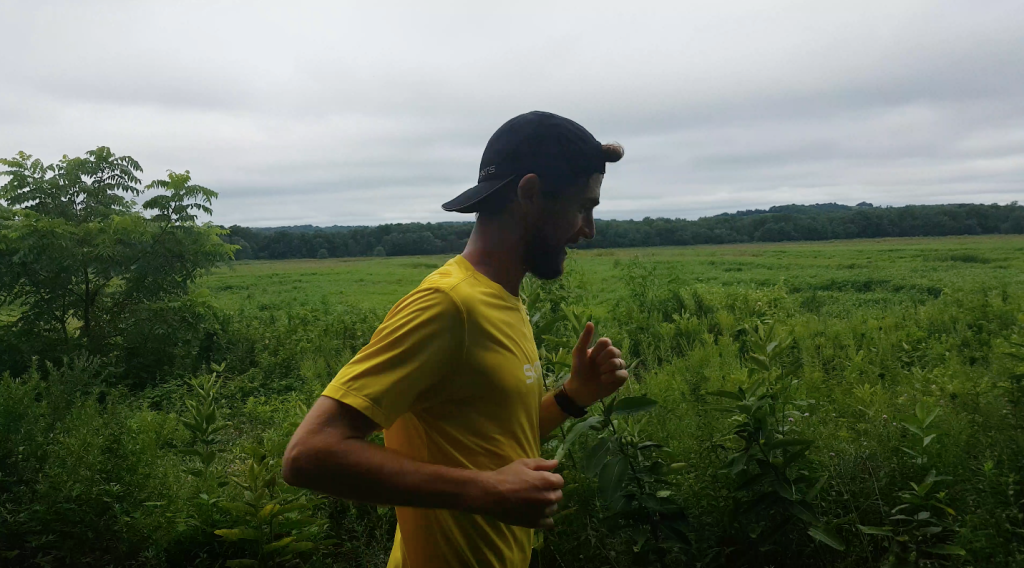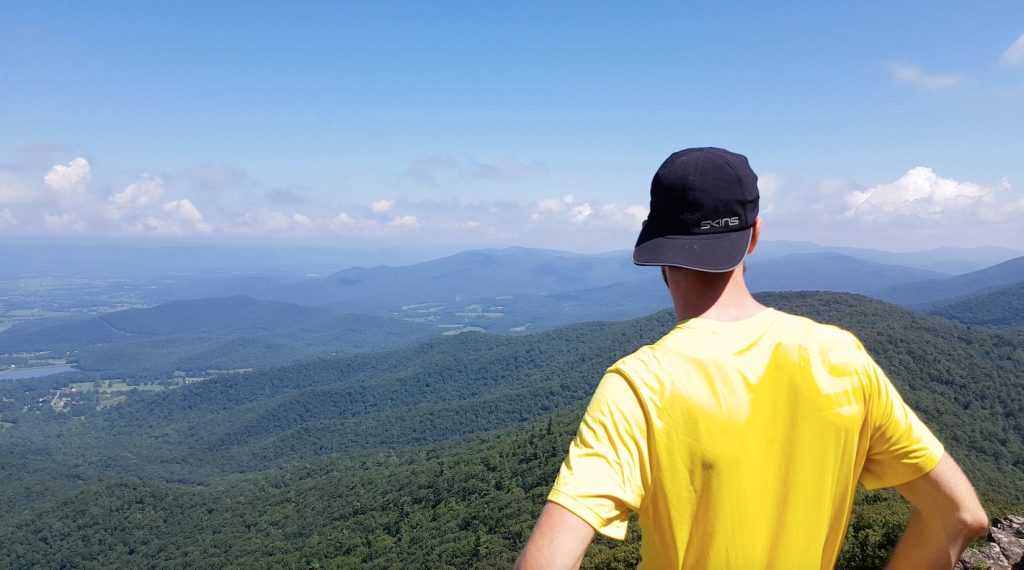With Mount Katahdin enveloped in a midday cloud on Aug. 28, Belgian ultrarunner Karel Sabbe summited Baxter Peak to claim the overall Fastest Known Time, or FKT, on the Appalachian Trail. He ticked off all 2,190 miles of the AT in 41 days, 7 hours and 39 minutes, eclipsing by more than four days the previous northbound FKT set last year. On his final push for the record, Sabbe ran for 32 hours for roughly 100 miles until he reached the trail’s northern terminus. “All I had was a seven-minute nap because I was falling asleep on the go,” said the 28-year-old dentist.
Sabbe said he averaged 53 miles a day and set the record for a supported FKT, meaning he had a small crew who followed him throughout the journey and provided him with food and other aid. In contrast, Joe “Stringbean” McConaughy, who set the self-supported record last year, carried all of his own supplies without any outside help. McConaughy still holds the self-supported record, while Sabbe has clutched both the supported title and the overall FKT.
“Karel’s run should raise a lot of eyebrows,” McConaughy said about the significance of Sabbe’s FKT, adding that Sabbe’s level-headedness is an important quality that enables him to accomplish great things. “He takes risks, he has big visions, but he knows that consistency wins in such a long feat.”
McConaughy and Sabbe have been engaged in a competition over the last several years. In 2014, McConaughy clutched the supported FKT on the Pacific Crest Trail, only to have Sabbe best it two years later. Sabbe now holds both the PCT and the AT overall FKT.
What is an FKT?
Quite simply, FKTs are speed records measuring how fast a runner can traverse a given route. People have long been testing the limits of their physical prowess by seeing how fast they could complete the AT. Initially, FKTs drew relatively little attention outside of a niche running community, but today the attempts have made the jump to the mainstream.
There has been a string of high-profile Appalachian Trail FKTs recently, starting with Scott Jurek’s record-setting northbound attempt in 2015 and Karl Meltzer’s southbound feat a year later. Both runners completed supported runs with the backing of big-name sponsors that drew considerable amounts of media attention.
“These guys raised the profile of FKTs because their sponsors were playing it up and promoting these runs,” said Peter Bakwin, an ultrarunner and founder of fastestknowntime.com, an online resource for all things FKT. And while that has changed the community, Bakwin said, the sport has remained authentic. “These runs are still very personal, challenging and a grassroots effort. When Scott [Jurek] ran the AT, folks would come join him for a day.”
Runners looking to set an FKT are beholden to a simple agreement: announce your intentions in advance (including to past record-holders), invite people to observe your attempt and record your attempt in detail. But, as FKTs have risen in popularity, it has become more difficult to prove them.

Sabbe used a GPS tracker and Strava, an app that tracks mileage, to livestream his progress. Photo courtesy of Karel Sabbe.
In recent years, dubious FKT claims have been discredited by Bakwin and the greater FKT community. “These guidelines help the athletes because [they’re] transparent. No one likes to have their claims questioned,” Bakwin said. Now, runners are encouraged to provide any proof they can along the way in addition to GPS tracks, such as photos.“New technology really helps, if the runners use trackers that allow for real-time reporting” he added.
That’s what makes transparency almost as important as running the miles—something Sabbe stuck to from day one, following all the protocols as closely as possible. He used a GPS tracker and Strava, an app that tracks mileage, to livestream his progress. He also ensured at least two people a day signed a Guinness World Records witness statement, documenting his progress when they spotted him.
“My main focus was FKT protocols and Peter Bakwin,” Sabbe said. “On the other hand, I applied for the Guinness World Record because for many people who aren’t in the hiking or ultrarunning world, they don’t understand FKTs that much. Guinness is the standard of world records—it’s something I did on the PCT as well.”
A Dentist from Belgium
Sabbe seemingly came out of nowhere with his record-setting run on the PCT in 2016. His first event was only a year before—New Zealand’s 150-mile Kathmandu Coast to Coast race on foot, bike and kayak, where he finished 37th out of 120 participants.
For most of the year, Sabbe is a dentist in Ghent, Belgium. He says that’s what serves as his inspiration to run. “At work, I really build up energy and need to get rid of it,” he says.
Sabbe isn’t a professional runner, rather he says the sport is a “hobby that got out of hand.” But he runs like a pro, thanks to a consistent training regimen. In prep for the AT, he logged up to 80 miles a week and spent a few hours in the gym, mostly on a stair-climber to mimic the elevation change he knew he’d encounter.
His mental preparation included keeping his life as close to normal as possible. “I didn’t stop going for drinks with friends or go to bed early leading up to the AT,” Sabbe said. “I didn’t want to be stressed. Instead I was relaxed and ready for six weeks of hardship.”

In the future, Sabbe plans to tackle another long trail. The Continental Divide Trail or New Zealand’s Te Araroa Trail are at the top of his list. Photo courtesy of Karel Sabbe.
On the AT, his mornings started at 3:15am and he was marking off miles not long after to beat the heat and get night runs out of the way when he had energy, mitigating the risk of falls in the dark. Injury on the AT due to falls have plagued most of the recent FKT holders, shaving off hours that they fought to gain back. But Sabbe was fortunate enough to have avoided any mishaps along the journey.
He stopped most days at 53 miles, never pushing much farther. “If you go for those high mileage days, your body reacts to it,” he said. “It’s harder to recover and often you get injured.” Sabbe’s brother-in-law and close friend, Joren Biebuyck, who provided logistics, planning and medical care, is also a physical therapist. Any slight twinges of pain were analyzed immediately, right on the trail.
While attempting an FKT on the AT, most supported runners sleep in a van at a road crossing each night. Sabbe often slept in the woods like a traditional backpacker with a small crew consisting of Biebuyck, as well as friends or Sabbe’s wife who rotated with a support car over the course of the journey. “Part of that strategy was because it’s more expensive to sleep in a van,” Sabbe said. Plus, having a cozy bed in a van at night would have presented a hard-to-resist temptation, he said, perhaps cutting his days shorter.
Sabbe says he plans to tackle another FKT on a long trail. The Continental Divide Trail would be next on the list if the route was officially complete, but he says he’s also eyeing New Zealand’s 1,850-mile Te Araroa Trail.
When it comes to the Appalachian Trail, Bakwin believes that Sabbe’s record, while the most impressive yet, can be beat—but he says it will take an extraordinary effort. “To beat Karel’s, the next person will need to have not only a great plan and good luck, but will also need to be a better athlete than Karel,” he said. “I have no doubt that’ll happen sooner or later, but Karel is definitely making it tough for that next person.”
